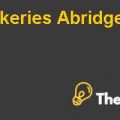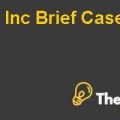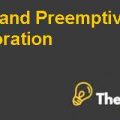Equity Value
However, the true picture of the scenario can be seen when the effect of debt and excess cash is included in the calculation of the enterprise value. The equity value per share can be calculated through dividing the resultant value by the outstanding number of shares. Thus, the maximum amount that Adecco can pay (in equity value/per share) without harming its own value is $19.81.
3.) Exhibit 13 forecasts are based on a set of assumptions about how Adecco could transform Olsten’s staffing business once it is acquired. Consider some other scenarios:
a.) Sales growth at 8% over the nine year period.
If the sales growth is stagnant at 8%, then the effect will be seen on the EBIT and so on the overall free cash flow. A single factor placed a very heavy effect on the enterprise value of the company. It dropped from the initial level to $8.93 by just changing the percentage growth rate of the sales.
b.) Sales growth at 8% + SG&A/Gross Profit at Adecco average for 1997 and 1998.
If these two factors are changed, then there will be a higher impact on the enterprise value of the company. SG&A/Gross Profit is an amalgamation of two factors thus the SG&A is changed to adjust the SG&A/Gross Profit at Adecco average for 1997 and 1998. The results dropped the company’s worth to further $6.16.
c.) Sales growth at 8% + SG&A/Gross Margin at Adecco average for 1997 and 1998 and Gross Profit/Sales to remain at Adecco average for 1997 and 1998.
If the three factors are disturbed, then the whole financial statement is turned upside down. To include the Gross Profit/Sales ratio in the statements, first the cost of goods sold is changed and then the gross profit is calculated again. The SG&A is also adjusted accordingly. The resulting effect of these changes on the Implied Share Price is a further drop to $1.55.
d.) Base case but with terminal growth rate of 3%.
If the long term growth rate is changed from 5 to 3 percent, then the implied share price will drop down slightly because the long term growth rate will affect the terminal value of the company. As the growth rate will decline, so will the enterprise value of the company.
4.) The case describes that Adecco initially offered $11 for the staffing business. You should disregard this offer since it was based on a different set of assumptions.
As Adecco, how much would you bid for Olsten? Discuss in-depth any factors that Bowmer should take into account when deciding on the offer? Explain how these factors affected your offer price for this acquisition? How would you convince the Olsten board to accept your offer?
Solution
An amount of $19.60 seems reasonable for acquiring Olsten. It is because of the other positive factors that it will bring in for Adecco as discussed in strategic and economic rationale. The effect of synergy will be visible, when the expertise of these two companies will merge together to adopt the best practices. Along with that, Adecco has served a good amount of time on measuring the compatibilities between the two companies.
The Adecco’s CEO, Bowmer should consider the fact that the costs will decrease and the revenue will increase. In these circumstances, the two plus two equals five statement holds true because more customers will be received after the merger and expansion.
In the Exhibit 4 of the case, it can be seen that the graph between market share and EBIT in gross margin is not linear, but curvilinear. This means that the synergy and larger market share along with compatibility will be observed in this merger. All the points are family positive for Adecco.
The Olsten board can be convinced by the fact that the company’s compatibility will ensure that the stakeholders are entitled to their rights and there is no disturbance in the processes. Along with that, the Olsten family can be given some amount of shares from the ordinary shares so that they feel connected to the company. Sometimes, the founders and the family members of the founding member of the company are attached to the firm and for this reason they are not interested in the sale of their equity.....................................
This is just a sample partial case solution. Please place the order on the website to order your own originally done case solution.











